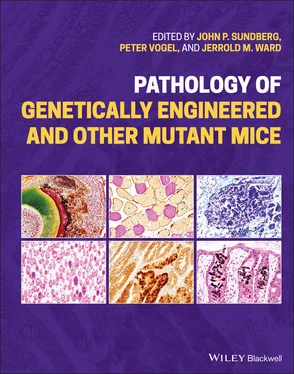Pathology of Genetically Engineered and Other Mutant Mice
Здесь есть возможность читать онлайн «Pathology of Genetically Engineered and Other Mutant Mice» — ознакомительный отрывок электронной книги совершенно бесплатно, а после прочтения отрывка купить полную версию. В некоторых случаях можно слушать аудио, скачать через торрент в формате fb2 и присутствует краткое содержание. Жанр: unrecognised, на английском языке. Описание произведения, (предисловие) а так же отзывы посетителей доступны на портале библиотеки ЛибКат.
- Название:Pathology of Genetically Engineered and Other Mutant Mice
- Автор:
- Жанр:
- Год:неизвестен
- ISBN:нет данных
- Рейтинг книги:3 / 5. Голосов: 1
-
Избранное:Добавить в избранное
- Отзывы:
-
Ваша оценка:
- 60
- 1
- 2
- 3
- 4
- 5
Pathology of Genetically Engineered and Other Mutant Mice: краткое содержание, описание и аннотация
Предлагаем к чтению аннотацию, описание, краткое содержание или предисловие (зависит от того, что написал сам автор книги «Pathology of Genetically Engineered and Other Mutant Mice»). Если вы не нашли необходимую информацию о книге — напишите в комментариях, мы постараемся отыскать её.
An updated and comprehensive reference to pathology in every organ system in genetically modified mice Pathology of Genetically Engineered and Other Mutant Mice
Pathology of Genetically Engineered and Other Mutant Mice
Pathology of Genetically Engineered and Other Mutant Mice — читать онлайн ознакомительный отрывок
Ниже представлен текст книги, разбитый по страницам. Система сохранения места последней прочитанной страницы, позволяет с удобством читать онлайн бесплатно книгу «Pathology of Genetically Engineered and Other Mutant Mice», без необходимости каждый раз заново искать на чём Вы остановились. Поставьте закладку, и сможете в любой момент перейти на страницу, на которой закончили чтение.
Интервал:
Закладка:
The advantage of creating congenic strains is that the gene of interest is now on the inbred strain the investigator wants to work with. The disadvantage is that there is always some remaining DNA from the donor strain around the gene that has been moved and potentially elsewhere in the genome. The more the strain is backcrossed to the new strain, the smaller this interval is, but some donor DNA still remains, and may be in small segments of forced heterozygosity not linked to the congenic interval. Endonuclease‐mediated technology can be used to replicate the same allele sequence in different inbred strains, which eliminates the problem of flanking donor sequence in the congenic interval and saves years of breeding.
There are also a group of strains generated by the outcross of a coisogenic mutant subline followed by backcrossing to the original inbred strain in order to return to something close the original genetic background. This can occur by error or by necessity, such as when the chimeric founder of a targeted mutation created in an ES cell derived from 129S6/SvEvTac is bred to C57BL/6NTac to select mice with an agouti coat color, indicative of transmission from 129S6. If it is desirable to assess the phenotype of the allele on a 129S6 background, then repeated backcrossing to that original background can produce something similar to a congenic in that it is predominantly 129S6 but may carry traces of C57BL/6NTac sequence even though the interval surrounding the mutation is 129S6. Such a strain would be named 129S6(B6NTac)‐ Gene tm1Lab/Lab with the abbreviation of the predominant strain followed by the abbreviation of the potentially contaminating strain in parentheses. This nomenclature says at a glance that this is not a congenic strain (no period), the allele did not originate in C57BL/6NTac, but rather in 129S6‐derived sequence, but that some contribution from C57BL/6NTac may be present in the genome. This nomenclature is only used after five backcross generations. Prior to that the correct strain nomenclature would be 129S6;B6NTac‐ Gene tm1Lab/Lab.
Consomic Mice
Consomic strains have one intact chromosome from the donor strain transferred to a host background through repeated backcrossing, similar to congenic mice, but with careful screening at each generation for a fully intact specific donor chromosome. The strain nomenclature for consomic strains places the donor strain as a superscript to the transferred chromosome. The strain C57BL/6J‐Chr 1 PWD/Ph/Fore had Chromosome 1 from the inbred strain PWD/Ph bred onto a C57BL/6J host background by Dr. Jiri Forejt, whose laboratory code is Fore. A complete set of consomic strains, in which each chromosome from the donor strain is separately transferred to the same host background in a panel of separate strains, provides a unique tool for mapping mutations and modifiers.
These types of mice can be quite valuable when multiple congenic strains are created, each carrying the same single gene mutation. If each strain develops different lesions or different levels of severity of lesions, then one can integrate this type of strain into the analysis. For example, a spontaneous hypomorphic allele of laminin gamma 2 ( Lamc2 jeb) resulted a model for non‐Herlitz Junctional Epidermolysis Bullosa, a blistering skin disease. Five congenic strains homozygous for this mutation revealed very different onset and severity of blistering disease and other lesions [30]. By crossing the congenic strains, several quantitative trait loci (QTLs) were identified, one major modifier gene on chromosome 19. By creating B6 and C57BL/6J‐Chr 19 PWD/Ph/ForeJ congenic strains that were both homozygous for Lamc2 jeb(on Chromosome 1), these mice could be crossed and each time rearrangements only occurred on Chromosome 19, thereby shortening the interval when selecting for disease severity. In so doing, it was possible to reduce the genetic interval to 1 megabase thereby identifying the binding region of Col17a1 as the major modifier gene [31].
Conplastic Mice
Conplastic strains have been created by backcrossing the nuclear genome from one inbred strain into the cytoplasm of another in which the mitochondrial parent is always the female parent during the backcrossing program. The strain designation is the nuclear genome strain‐mt cytoplasmic genome strain. For example, C57BL/6J‐mt A/J/Na is a strain with the nuclear genome derived from C57BL/6J and the cytoplasmic genome from A/J, which was created by crossing male C57BL/6J mice with A/J females [32]. Their female progeny were repeatedly backcrossed to male C57BL/6J. As with congenic strains, a minimum of 10 backcross generations are required.
Outbred Mice
Wild mouse populations are generally not inbred, and some populations have great genetic diversity between individuals. Exceptions occur when there is severe geographical isolation in which gene diversity is mixed but less so than in large free‐ranging populations. The result of outbreeding is various degrees of genetic and therefore phenotypic variability between individuals ( Table 3.10). Since human populations, in general, are outbred, properly maintained outbred mouse stocks can, in many ways, be better models for the general human population for identifying population outliers/rare susceptibility in toxicology and other types of studies. One big advantage of outbred stocks is that fecundity, reproductive efficiency, is usually quite high compared to inbred animals. This translates to lower costs to produce large numbers of animals in a short period of time. The major disadvantage is that because of the high phenotypic variability between individuals, large numbers need to be used to generate valid results, and the colony size and breeding schemes necessary to prevent inbreeding are large and more complex. This variability severely limits the ability to do highly refined research to ask very specific genetic and environmental questions about effects on disease or other phenotypes. But if the goal is to look for rare events, such as adverse drug reactions, these types of mice might better reflect the response in humans. This depends, of course, on breadth of alleles in the starting population and the rigor with which the outbred population is maintained. Defined outbred stocks are closed colonies, and inadvertent selection for fecundity, size, or health are selective pressures that reduce the genetic diversity of the population, as is any passage through a genetic bottleneck such as can occur during rederivation.
Table 3.10 Outbred mouse stocks.
| Advantages High genetic and phenotypic variabilityCan be more reflective of the general outbred human populationRobust (high fecundity)Inexpensive |
| Disadvantages Large numbers needed for analysisHigh variability in results |
| Uses Widely used in all types of researchModels for human disease with variability between patients (population outliers) |
One of the most commonly used outbred stocks is Crl:CD1 mice from Charles River Laboratories. This and other related “Swiss”‐derived stocks originated from seven females and two males were sent from a non‐inbred albino stock of Dr. Andre de Coulon at Centre Anticancereux Romand, Lausanne, Switzerland to Clara J. Lynch at Rockefeller University in the United States in 1926. These mice were further developed into the Hauschka Ha/ICR stock, which was initiated in 1948 at the Institute for Cancer Research (ICR) in Philadelphia. In 1959, a colony of mice, then maintained at Roswell Park Memorial Institute, were send to Charles River designated as HaM/ICR ( https://www.criver.com/sites/default/files/resources/CD‐1IGSMouseModelInformationSheet.pdf). Today on the Charles River website you will find various trade names for different colonies of these mice including CD1‐Elite (SOPF) or CD1‐Elite Mouse. However, the correct formal nomenclature for the stock is Crl:CD1. While it is commonly used as an outbred stock, the genetic diversity from the small number of albino progenitors used and variability of sublines passed between institutions make this not the best example of an outbred stock.
Читать дальшеИнтервал:
Закладка:
Похожие книги на «Pathology of Genetically Engineered and Other Mutant Mice»
Представляем Вашему вниманию похожие книги на «Pathology of Genetically Engineered and Other Mutant Mice» списком для выбора. Мы отобрали схожую по названию и смыслу литературу в надежде предоставить читателям больше вариантов отыскать новые, интересные, ещё непрочитанные произведения.
Обсуждение, отзывы о книге «Pathology of Genetically Engineered and Other Mutant Mice» и просто собственные мнения читателей. Оставьте ваши комментарии, напишите, что Вы думаете о произведении, его смысле или главных героях. Укажите что конкретно понравилось, а что нет, и почему Вы так считаете.












